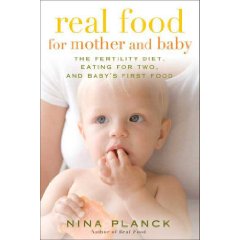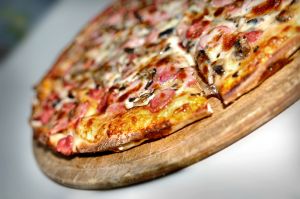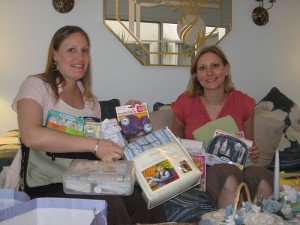I should be drinking whole milk while I’m pregnant? And better than that is unpasteurized, raw milk?
I should stay away from a low-fat diet? Especially while I’m pregnant?
What is “carbage”?
It’s okay to feed my baby meat?
So, can I or can’t I eat fish while I’m pregnant?
Industrial fats like corn, sunflower, safflower, and soybean oil are making me fat and causing heart disease and diabetes? You mean butter, coconut oil, and lard are better choices?
What foods are good to introduce to my baby?
You mean babies don’t NEED cereal when they first start eating? Are you crazy?
 I recently read Nina Planck’s book Real Food: What to Eat and Why based on the recommendation of a friend. Thanks Heather! She also recommended Planck’s next book, Real Food For Mother and Baby. When she told me that the book explains why mothers need more than iron and folic acid when they are pregnant and even trying to conceive a baby my interest was piqued.
I recently read Nina Planck’s book Real Food: What to Eat and Why based on the recommendation of a friend. Thanks Heather! She also recommended Planck’s next book, Real Food For Mother and Baby. When she told me that the book explains why mothers need more than iron and folic acid when they are pregnant and even trying to conceive a baby my interest was piqued.
This book will turn many of your thoughts about food upside down. Nina is aon a mission to help people understand why it is important to eat “real food”. Real food is food that people have been eating for thousands of years. The kind of food that is minimally processed–meaning milk that comes straight from the cow, beef that is fed grass not soybeans and corn, grains that have been soaked, plain yogurt with your own added flavor, poultry that is allowed to roam and eat grass and bugs. You get the idea. Planck makes the argument that “industrial foods” are ruining our health. Soybean, corn, safflower, and sunflower oils are commonly added into our foods. They are also highly processed and increasing our bad cholesterol. The information in this book will make your head spin because it demystifies so much of our wrong thinking about food.
This book addresses all those questions I wrote above. The first chapter is basically a summary of her first book Real Food. I highly recommend reading her first book to get more of the science and information behind her food recommendations. It is eye opening. Chapters 2 and 3 deal with pregnancy and nutrition during pregnancy. Chapter 4 covers breastfeeding. This chapter may make your eyes get as big as saucers in some parts but it is interesting all the same. She covers why breastmilk is best for baby, what she would do if she had trouble nursing her baby, how formula is made, some of the basics of getting baby to breastfeed and even some anthropological implications for why we have to nurse so often. Chapter 5 covers first foods for your baby. This chapter has seriously made me rethink how I want to introduce foods to any additional children we may have.
This book, along with her first book, has caused me to reconsider the kind of foods I want our family to eat. One thing that I really appreciate about her approach is that she recognizes that eating a traditional, REAL FOOD diet can be pricey. Time magazine just had an article covering the benefits of grass fed beef for farms, farmers, and consumers. The article showed how it is cheaper to buy unhealthy, industrial food than healthy, traditional foods. Many of us are on strict budgets and have difficulty paying for free range chicken and grass fed beed for every meal. She encourages people to pick and choose wisely and get the best that you CAN afford. Can’t find raw milk? Then buy organic whole milk. Can’t afford organic? Then at least drink whole milk. She does recommend that we stay away from all foods that come with industrial indredients and not to fall prey to marketing schemes that tell us that processed foods are good for us.
When we get to England I am planning on implementing several things in the books I have been reading in the last few months about food. One thing I want to do is avoid ALL forms of industrial food: corn oil, high fructose corn syrup, soybean oil, white flours, processed grains, powdered skim milk…you get the idea. It seems almost impossible but I’d like to try it for at least a week and see how we do. I figure since we are moving to a different country it might be easier to stop buying some of our industrial food culprits.
Other books I’ve been reading on the topic of Real Food:
The Omnivore’s Dilemna
Nourishing Traditions
Real Food: What to Eat and Why
Have you read this book? What do you think? Does the idea of drinking whole (raw) milk freak you out? Eating whole, unprocessed, real, traditional foods has been getting a lot more press recently. What have you heard?








